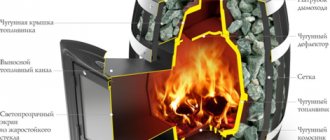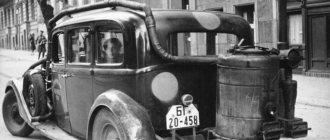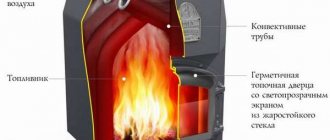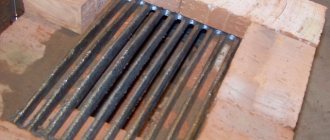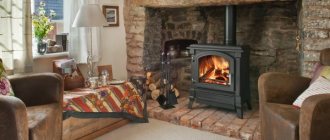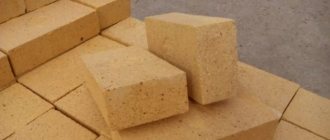Types of grate devices
The grates separating the combustion chamber from the ash pan are classified according to the following criteria:
- material of manufacture;
- designs.
Material of manufacture. These perforated plates are made of cast iron or steel; cast iron plates are made by industrial casting; steel plates can be made independently.
For reference. Products made of cast iron (grade SCh-15 or SCh-20) are heavier, but the cast iron grate is more heat-resistant, resistant to aggressive combustion products and is therefore preferable for the stove.
Design.
The movable devices consist of several lattice fragments and an adjusting rod, with which you can change the angle of the lattice ribs relative to the vertical and thereby adjust the size of its gaps. Models of such units differ in the angle of rotation of the adjusting rod, but they are all used in long-burning heating units (not all modifications) and are difficult to manufacture in domestic conditions.
Fixed grate partitions are grates of various sizes and configurations, collapsible or solid, designed for a specific heater design. They are motionless after installation, and their parameters are unchanged.
According to their profile, fixed grates are also divided into groups:
- tile - a rectangular flat grate, with or without stiffening ribs at the bottom, used for any stoves, fireplaces and solid fuel boilers;
- collapsible beams - a prefabricated structure from individual longitudinal cast iron slats, which allows you to assemble a lattice device of any contour;
- basket is an outdated device used in open-type kitchen hearths.
Types of grates: from left to right - flat, beam (segmental), basket.
There is another type of movable grate - chain, but its design does not ensure complete combustion of solid fuel and is therefore used very rarely.
Types of grates for furnaces

By material of manufacture, cast iron products are the most common
Despite their narrow functionality, stove grates differ in several ways. The raw material for the manufacture of parts is iron with a certain carbon content, which makes it resistant to high temperatures. The most common is cast iron; heat-resistant steel alloys are used less frequently.
Since solid fuels have different designs, shapes and sizes, ash pans for stoves are characterized by a variety of manufacturing options.
The following product categories can be distinguished:
- Solid. They are monolithic parts obtained by forging or casting. They cannot be disassembled; there is only the possibility of precise adjustment to a specific installation location.
- Typesetting. The presence of locking connections on the parts makes it possible to assemble a grate of the desired shape and size for almost any firebox.
- Fixed. Once installed in the combustion chamber, they occupy a fixed position that cannot be changed if circumstances so require.
- Movable. Products can change position in the space for cleaning; some models have the function of adjusting the width of the gaps between the crossbars.
What is a grate and why is it installed?
The grate is a grate that allows the air flow to penetrate directly to the combustion site from below, and the ash to fall through the holes into the compartment reserved for it. It can be cast iron or steel. Installing this accessory solves a number of problems , in particular, it:
- Divides the firebox into two zones - the combustion chamber itself and the ash pan.
- Used for placing and drying fuel.
- Distributes the air flow from the ash compartment.
- Provides high-quality traction.
- In combination with the door, it allows you to control and adjust the flame.
It is not possible to make a grate intended for installation in a furnace from every metal. After all, it is exposed to high temperatures and under the influence of atmospheric oxygen can oxidize quite quickly. Only cast iron can resist such a complex destructive influence for as long as possible.
Specifications
There are many types of stoves, varying in size, type of fuel used, and other characteristics. Therefore, the grate for them will also be different. As for the material of the stove itself, it does not directly affect the choice. Grates are installed in brick, steel, and cast iron devices.
Type of design
There are gratings:
- monolithic;
- typesetting;
- refrigerated.
Monolithic are solid structures. Dimensions are selected depending on the depth and width of the combustion chamber.
Available to fit all standard firebox sizes. This option is the easiest to install.
The typesetting version is made up of individual rod elements. It is used if a standard one cannot be selected, for example, in non-factory-made ovens.
Important! Often the rods are wedge-shaped. When installing, they are positioned with the narrower part down
This increases service life.
Cooled ones are used in systems with heat exchangers. They are made of tubes through which coolant passes. Thus, the grate itself is cooled, and the overall efficiency increases. This option is more often used in solid fuel boilers. The temperature inside the chamber reaches 1000°C. Thanks to cooling, the material can withstand a similar thermal load.
Form
The grate bars differ in the shape of the canvas. Different types are used in different designs. The following types of gratings are available:
- flat;
- basket;
- movable;
- beam
Photo 1. Basket grate made of cast iron. This type of device is usually installed in fireplaces.
Flat (or tiled) - the most common type. They are installed not only in stoves, but also in boilers that burn solid fuel, as well as in fireplaces. They have a rectangular shape. The dimensions are standard, selected depending on the dimensions of the fuel chamber.
Baskets have curved edges, which is why the whole structure resembles a basket. Such structures are placed in open-type ovens intended for cooking. Since such stoves are rare nowadays, and the parts for them are also not very common.
Movable grates are installed in long-burning furnaces, where it is necessary to regulate the air flow. The design allows for the possibility of changing the width of the gaps. They have several sections and a shaft, thanks to which movement occurs. Rotation axes can be horizontal or vertical. An additional advantage is greater ease of cleaning.
Beams consist of individual crossbars (beams), which can be single or double. They are typically used in non-standard sized ovens.
Size
The dimensions of the product depend on two parameters:
- dimensions of the furnace combustion chamber;
- type of fuel used.
In equipment operating on wood, peat and fuel briquettes, a width of 150-350 mm (in increments of 50 mm) is most often used.
The depth is usually 180 or 250 mm. The largest possible dimensions of standard models are 900x800 mm.
When coal burns, more harmful substances are formed. Therefore, the dimensions of the grille should be larger, from 300-350 mm on both sides.
In any case, gaps of at least 5 mm are left at the edges. They serve to compensate for expansion when heated.
Attention! When choosing a size, the weight of one load of fuel is also taken into account. Dimensions, especially thickness, are selected in such a way as to withstand this load
Grate for the stove: choosing the best cast iron grates

A stove design with a closed combustion chamber or an open hearth with a grate will work best with cast iron grates. But the correct choice of this element depends on several factors:
- Combustion chamber size;
- The type of fuel that is planned to be used;
- Furnace designs;
- How to use the oven.
Grate bars cast from cast iron are made in the form of a solid grate, a grate with jumpers, in the form of individual elements and special types of grates designed for open hearths.
The fact is that the length and width of the combustion chamber for stoves of different designs have significant differences. Some stove designs have a rectangular firebox, with grates covering the entire area. For other ovens, a small grate 25 cm wide and 30 cm long is sufficient. Some stoves are designed to fire logs of double length - 80 cm or even 1 meter. Therefore, when choosing, the size of the firebox is taken into account. Single beam models are also important for construction - a full standard grate is not always required, especially in small ovens; many of them are small in size and can get by with 4-5 grates.
For a stove that uses only wood, standard grate sizes of up to 25 cm in length are usually selected. In rare cases, when meter-long logs are used, the grate length is selected to a maximum of 900 mm and a width of 800 mm. But to use a furnace for coal, the grates are selected to be larger in size - 350 by 350 mm. In this type of product, not only the dimensions are increased, the thickness of the casting itself is slightly larger than conventional wood grates, but the distance between them is slightly smaller. This shape is necessary to retain small coals; when burning wood, the size of individual coals is much larger than that of hard coal.
The design of the furnace is also taken into account - for heating furnaces, mainly long grate models are used, in which the casting of the ribs has jumpers between them. And in heating and cooking stove models, grates with a large number of rods in the grate are used, this allows for several modes of fuel combustion and several options for heat treatment of products, from fast heating to slow smoldering on coals.
And of course, experienced stove makers will advise installing grates with rods depending on how the stove will be used. This concerns, first of all, the process of adding fuel to the firebox. If a firebox door is used, then thin grates can be installed, and if loading will be done through burners, then it is worth thinking about the additional strength of the metal.
Do-it-yourself grate: materials, design, stages of work
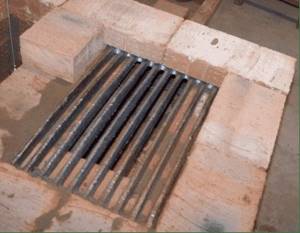
There are several options here. The only difference is the purpose for which the lattice needs to be made. For small stoves, which are mainly used for periodic heating of premises, for example, for a potbelly stove, you can use construction fittings with a diameter of 10-12 mm. But for capital heating or heating-cooking stoves, it is better to pay attention to two options - from structural reinforcement or from corners. The advantage of steel reinforcement lies in the availability of this material and the possibility of using previously used sections. In addition, steel reinforcement is more suitable for grates; it does not burn out so quickly, and it is not greatly deformed under the influence of temperature. On the other hand, to assemble this element it is necessary to use reinforcement with a large diameter - 16,18 or even 20 mm. This makes it possible to extend the life of the grille.
The use of steel angles makes it possible to quickly replace a worn-out element; they are not as expensive as other types of rolled products, and by their design they are able to withstand a greater number of heating and cooling cycles than a profile pipe or rod.
The manufacturing technology is quite simple. To assemble a structure from steel reinforcement, it is recommended to first make simple calculations. First you need to calculate the geometric dimensions of the lattice. Here the length, width and height of the product are taken into account. In this case, the height plays no less a role than the length and width; a discrepancy between the height and the cast iron parameter will not allow the grate to be correctly installed in place. A height that is too small will interfere with proper loading of fuel, and a height that is too high will raise the grate above the surface of the bricks, and thus create a space in which ash and unburned fuel will accumulate.
The next step is to calculate the area of the grating. Next, the number of rods is calculated. First, 40% of the area is calculated, approximately how much is occupied by the spaces between the rods. And then the number of rods is calculated. When calculating, it is recommended to round the resulting values; it is not necessary to strictly adhere to the figure of 40%; nothing bad will happen if the gaps are 35 or 45% of the grating area.
The stage of practical work begins with the preparation of material for work - first, the rods are cut; accuracy and precision are required here. After this, a template for assembly is made, markings are made on a section of the board, and nails are simply hammered in to secure the sections of reinforcement. After checking the correctness of the layout, electric welding connects all the elements into one structure. First, tack is done at several points, and then all seams are finally welded around the entire circumference.
Upon completion, the resulting structure is checked in all planes; this is done on a flat surface using a bench angle - all angles must be correct, the lattice itself must be in the same plane. No bends or deformations.
Peculiarities
The grate is made by hand as a single piece; most often, cast iron is used for its production. The grille of the structure has holes through which air is drawn to the fuel.
The part is laid in such a way that the grille holes are directed from the door opening to the rear wall. For large combustion chambers you will need several grates.
It is quite possible to make a grate with your own hands. It is an important element in the combustion chamber, thanks to which it is possible to obtain efficient combustion of fuel. The designs of modern furnaces and boilers are constantly changing, and details are being improved. But there is a functional element that you can’t do without. This element is the grate.
The grate serves to support wood, coal and fuel briquettes. Through its holes, ash pours down, thereby freeing up space for a new batch of firewood. Grate bars vary in design and are made from different materials.
Video: How to put a grate in the oven
The designs of modern stoves are constantly being improved, changed, and supplemented. However, there are elements whose functions are difficult to do without. As an example, you can install grates for the oven (grid).
The grate is a part of the combustion chamber that supports logs, coal, and fuel briquettes. Through the cracks in it, the ash falls down, freeing up space for a fresh portion of fuel. There are different design solutions for these elements; they are made from different materials. From the article you will learn how to choose and how to properly place the grate in the oven.
Types of grates for a fireplace or stove
For the manufacture of grate bars, various materials and various designs can be used. In most cases, heat-resistant steel or cast iron is used.
The fact is that the grate bars are continuously exposed to fire and therefore it is better to choose cast iron, as it has a high strength index. There are two types of grate:
- typesetting;
- whole.
The furnace firebox can have different sizes and shapes, so furnace casting manufacturers make all sorts of configurations. For a firebox with non-standard dimensions, you can also easily select a suitable model. Solid types include monolithic types without the possibility of disassembly. The choice of sizes is quite wide, so the main reference point is the firebox area. The basis of typesetting models is made up of several individual elements. This is something like a construction set that you can assemble with your own hands and get the desired grille size.
Steel grates for a type-setting stove have the form of a conveyor belt and are called chain grates, and models with the possibility of cooling and made from pipes with your own hands are called pipe grates.
Cast iron grates can be of several types:
- tiled. Rectangular models used for solid fuel boilers, fireplaces and heating stoves. They are universal, the main thing is to determine the standard size;
- basket Ideal for an open hearth. The main purpose is cooking, but today they are used extremely rarely, since the design is morally outdated;
- beam These models owe their name to their resemblance to construction beams. They have the appearance of a stacked structure and consist of double or single elements. The optimal solution if it is necessary to assemble a grate of a non-standard size;
- movable. Such gratings have a design feature that allows you to change the width of the gaps, which is often not enough during installation. In most cases, they are used in long-burning furnaces.
What types of grate designs are there?
If we talk about products made of heat-resistant steel, then there are pipe and chain varieties of grates.

As for cast iron grates, there are several types:
- Tiled . Such rectangular grates are widely used in solid fuel stoves and boilers, fireplaces. We can say that these are universal products. You just need to choose the right grate size.
- Baskets . This type of grate was used in open hearths where food was prepared. Currently, they are practically never found.
- Beam . Externally, such grates resemble beams for construction. They are single or double stacked parts from which you can build a grill of any size.
- Movable gratings . The peculiarity of this design is that the grille links can be moved in a horizontal plane, changing the clearance between them. As a rule, such grates are used for long-burning furnaces.
Classification of grate
Cast iron grates for stoves were and are still the best option. Steel is less resistant to this mode of operation and is not able to accumulate heat, as cast iron does. Therefore, despite the heaviness of the material, it is cast iron wood-burning stoves - Harvia, for example, and cast iron grates that are considered the best. Moreover, this applies to models both for baths and for heating living quarters.
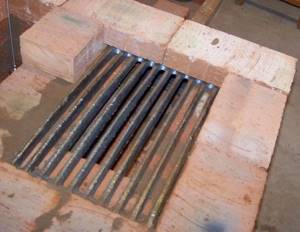
However, this classification exists:
- steel gratings are lighter. If you know how to handle a welding machine, they can be made with your own hands - for a bath structure, for example. However, the material burns out faster because it is less resistant to chemically aggressive substances.
- Cast iron grates for sauna stoves or other structures are much more stable and, therefore, have a long service life.
Another classification of devices is related to the type of device.
Fixed - usually a lattice with different sizes for different types of construction. This element does not change its parameters and does not move. There are several types of grating:
- tiled flat - lattice flat rectangle. This is the most popular option and is used for any wood-burning sauna stoves, solid fuel heating boilers, fireplaces, and so on. The photo shows the Harvia model.
- basket - designed for open fireboxes and originally developed for cooking. This device is no longer used, and there are almost no open fires, so the popularity of this model is not great;
- beam - in appearance they resemble a construction beam. The lattice of them is assembled with your own hands, choosing the appropriate size and quantity. This is the best method for fireboxes of non-standard sizes.
Movable grates are extremely rare in everyday life, as they are designed for long-term heating devices. Such an element consists of several gratings and a shaft. When changing the angle, the size of the clearance also changes, which allows you to effectively regulate the heating. Based on the angle of rotation, devices are divided into swinging and full-rotating.

The chain grate belongs to the same category: its elements are connected by chains. However, in practice it is extremely rare, since it does not ensure complete combustion.
How to install a grate
To select the appropriate device, the most important are the dimensions of the grate for the stove, and not its purpose - for a bathhouse or living room. Moreover, both the dimensions of the furnace structure itself and the type of fuel are important here.
So, for coal, the grate should be more massive, since the weight of stone fuel is higher, while for wood, you can choose a lighter model.
It is worth paying attention to the total number of gaps - at least 40%, otherwise the air will flow poorly, and the accumulating ash will not be poured into the ash pan
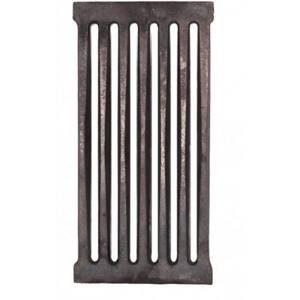
The installation process itself is extremely simple.
- The grate bars of the stoves are laid with your own hands on a stone ledge formed from brick during laying, or welded to the walls of the body of the iron sauna model.
- The gap between brick and cast iron must be at least 5 mm. There is no need for this in a steel structure for a bathhouse, since the thermal conductivity of metals is much closer.
- As a rule, the cast iron grate is placed 1-2 rows below the fire door to prevent coals from falling out.
- After laying, the gap is filled with sand - it will compensate for the expansion of the metal when heated.
The view shows the installation process of the grate.
Correct selection of grate
There are not many rules when choosing this accessory, but they are important:
- the lattice partition is selected depending on the type of fuel - for wood and briquettes, devices measuring 33 x 25, 30 x 25, 25 x 25, 25 x 18, 14 x 18, 14 x 12 cm are installed, and for coal 35 x 20.5 or 30 x 20.5 cm, which is due to the large release of harmful substances when burning stone fuel;
- for coal-fired furnaces, a perforated partition is also chosen with a larger cross-sectional area, preferably cast iron, in order to prevent its deformation under the influence of high temperature and the weight of coal;
- the total area of the gaps should be approximately 40% of the total area of the grate; a smaller value will not provide sufficient air supply, and through excessively large holes, unburned coals will fall into the ash pan;
- the choice of grate size for a brick heater is made taking into account a gap of 0.5 cm between its contour and the stone;
- Of two identical products, the cast iron part has the greater weight.
In addition, when purchasing a grate for a brick unit, it is necessary to calculate the contour of the seat. The data given in the table below will more clearly show what is meant.
Design features of the fireplace grate
The main materials for it are cast iron (more durable, resistant to high temperatures, and, as a result, durable) and steel (lighter and can be easily manipulated to achieve the required configurations). No less important than the choice of material is the accurate calculation of the open cross-section of the grate, that is, the amount of air that will enter the fireplace firebox through its grates.
Grate for the furnace: design options and replacement rules
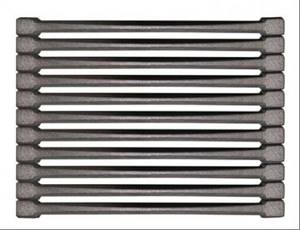
A one-piece casting, as well as a stacked design of individual grates, have their own installation specifics. This concerns, first of all, the thermal gap between metal and brick. And this applies to the masonry of the firebox made of fireclay refractory bricks. For normal functioning, a gap of 0.5-0.7 cm is made between the metal and the masonry. Cast iron, like any other metal, expands when heated, and this half a centimeter is critically not enough for the normal functioning of the stove.
The second point is that during construction the lattice is installed in grooves prepared in advance in the brick. This allows for reliable fixation of the metal. The grooves are made of sufficient depth so that the top of the grate is flush with the surface of the brick that forms the bottom of the firebox. Fixing the lattice itself is usually not done, since the already large mass reliably fixes it in the structure. However, you can fix the grate with sand or a clay-sand mixture.
A stacked grate of individual grates is usually installed taking into account the thermal expansion of the metal, but the dimensions of the grooves are strictly observed. If the grooves are large, the grate bars will not hold their shape. Many stove makers resort to such a technique as a set of grate bars in a cage. To do this, they use a metal profile or profile pipe, cut along the central axis. The ends of the grate are inserted into the profile, the edges of the profile are welded so that a simple but at the same time rigid structure is obtained.
To fix the grating during laying, cardboard or pieces of fiberboard are usually used. Before the first fire, they are simply removed, leaving a gap free.
How the grate is mounted and works
The installation site for the cast iron grate for RD-3 furnaces is the lower section of the fuel combustion chamber. There should be a minimal gap between the brick wall and the cut of the grate: sand is poured into it. It acts as an expansion joint, leveling the thermal expansion that occurs with the cast iron element. Thanks to this, the brickwork receives protection from destruction.
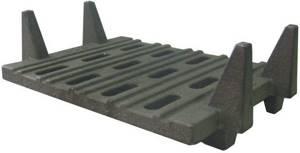
Firewood is loaded into the fuel compartment on top of a cast iron grate and set on fire. RD-3 demonstrates high resistance to the destructive effects of heat, combustion products and oxygen. This provides it with a fairly long service life, with full preservation of all operational characteristics.
Making a grate at home
You can make a grate with your own hands only from steel, since it is almost impossible to make a structure from cast iron at home.
For work, it is better to choose fire-resistant steel, but this is not a prerequisite. It is necessary to take into account what type of fuel the grate will be made for; its size depends on this.
For coal, a design of 300x300 mm or 350x300 mm is suitable, and for burning wood, the size of the grate will be from 140x120 mm to 300x225 mm.
Using simple iron, it is necessary to plan the stages of work so that in the end the grate is thick enough. You can use steel strips and reinforcement. Before you start making a grate with your own hands, you need to take the dimensions in advance. The next stage is the production of the frame.
The frame is considered the basis when installing the grate; later, parallel elements are welded to it
It is important to choose the correct distance between elements in the frame. Here it is necessary to take into account that ash does not leak through the holes, and air can circulate freely to maintain combustion
Holes in the grill should not occupy more than 40% of its area. Do not forget that compliance with safety regulations has not been canceled. It is worth taking care of clothes and shoes in advance, especially at the welding stage.
What is needed for production?
It is possible to make a grate with your own hands. What to make a grate for the oven from? It is better to use heat-resistant steel as a material, because it is impossible to work with cast iron at home. To make the grille, you can use any materials that have heat-resistant characteristics. This could be fittings, corners, steel pipes or strips of metal.
To make grate bars you will need:
- the metal from which the grille will be made,
- steel rods for creating partitions;
- ruler, tool for making marks;
- grinder for cutting material;
- welding.
From reinforcement
It is not difficult to make a grate from reinforcement yourself. It is enough to select the desired length of the product and cut the reinforcement with a grinder. It is necessary to determine the number of strips and take into account clearances for ventilation.
When the required amount of material has been prepared, you can begin welding the grate using rods. Do-it-yourself grate bars for the stove made from reinforcement can be seen in the photo below:
Ways to solve the problem
If the grate is damaged, there are two options: fill the ash chamber with a brick or install a new grate.
The option of filling is acceptable only if the integrity is damaged or there are cracks and it is impossible to eliminate them at the base of the ash pit. At the same time, it would be good to replace the firebox door from a blank door to a door with a grille to regulate the flow of secondary air. But this option will definitely create a lot of unnecessary trouble and reduce the efficiency of the furnace. Therefore, we change the grate.
The grate is usually made of cast iron. Cast iron is very different from brick in terms of CTE - coefficient of thermal expansion. This indicator for iron is much higher than for ceramics. Therefore, the grate is always placed freely with a gap of 5-10 mm around the entire perimeter. Some manuals recommend filling the gaps between the masonry and the grate with sand. But this is very stupid advice. Unnecessary and even harmful. Firstly, the sand from the heat of the coals (and it can reach 1100 degrees Celsius) simply sinteres - vitrifies, tightly welding the grate to the masonry and depriving it of the necessary freedom. Secondly, after the first fire, this gap is filled with ash - a non-flammable and non-caking material. So why make unnecessary movements?
The figure shows the correct (bottom) and incorrect (top) position of the grate
Usually the grate is placed in a brick trough or in grooves selected in the brick. If the integrity of these grooves is damaged and it is impossible to restore them, you will have to come up with some kind of supports. Sometimes they try to get out of the situation by driving nails, metal plates, etc. into the seams of the masonry. All this is in vain - the metal is quickly tempered and ceases to hold the grate, and more massive pieces of iron are unacceptable - they will tear the masonry.
Cost of examination of grate bars
The cost of conducting an examination of the quality of grate bars is often a significant amount. As a rule, it ranges from 4,500 rubles. up to 30,000 rub.
Accept claims and get free legal advice today! Call:
- Moscow
- St. Petersburg +7 812 309-16-31
- Hotline in the Russian Federation 8 800 511-69-34 (free)
return money
We recommend solving the problem now - a correct and justified claim is the key to success!
Important!
From 4,500 rub. up to 30,000 rub. This is the amount of money the research can cost.
Expenses for conducting the examination may be borne by:
- store (authorized person) - As a general rule;
- consumer - if the examination is a consequence of his personal initiative.
Important!
Subsequently, all costs will have to be paid by the guilty party. For example, if the consumer paid for the examination, but the defect turned out to be a manufacturing defect, then the consumer must be reimbursed for the amount paid.
Types of grates
Grate grates are divided into several varieties according to different criteria.
So, they can be divided into monolithic and typesetting.
— Monolithic models of gratings are more common, they are much easier to install - they immediately fit into a nest prepared for them of the required dimensions. The wide range of shapes and sizes of gratings on sale most often allows you to get by with just this option.
Options for monolithic and prefabricated grate
— Prefabricated grate bars are assembled into a single structure directly at the seat. These can be modules with two or three jumpers.
A prefabricated grate is convenient in cases where the bottom of the combustion chamber has a complex geometric shape, that is, it should be narrower in one place and wider in another.
This also includes the so-called beam grate - this is also a stacked version, consisting of individual crossbeams. The elements of the beam grille must pass freely and be removed from the combustion chamber through the open door. Actually, if you look at it, it is precisely such a separate beam that is called a grate.
Prices for grates for ovens
In practice, monolithic grates, if necessary, can be combined with stacked elements, in the case of the same non-standard shape of the combustion chamber.
The slab grate has a flat shape (usually rectangular, although there are also round grates). This product option is suitable for most solid fuel heating appliances - stoves, boilers, fireplaces. The slab grate is selected in accordance with the furnace design, which specifies the parameters of the seat.
Basket grate “Riva Grate”
Basket type grate. This type of grate was previously widely used in fireplaces with open hearths. It is convenient because the firewood being laid is not on the surface of the grate, but as if inside it, without the risk of falling out through the open hearth. But at the same time, air access to the fuel is completely preserved.
Nowadays, basket grates are no longer used in fireplaces so often, since many home owners prefer mainly closed combustion chambers with panoramic glass doors. However, such grates are also available for sale. In addition, master blacksmiths willingly accept orders for their production according to individual projects. And then the basket grate also becomes a decorative part of the fireplace.
Basket grate for the fireplace, made to order by a craftsman
A movable grate is usually intended for long-burning furnaces. The structure may consist of a frame and a grille installed in it on the axis. Another option is gratings with horizontal movement. Changing the position of the grate helps its self-cleaning - it helps to loosen slag or ash deposits and remove them into the ash pan chamber. In some cases, movable grates also change the geometry of the channels for incoming air, which is used to control the operating modes of the furnace.
One of the design options for a movable grate
There are models with sections rotating 180 degrees. However, this design must be included in the furnace design, since such movement of the grate requires special recesses in the brick wall. Therefore, these models have limitations in application and are quite expensive.
Separately, it is worth highlighting the cooled type of grate, which is usually installed in hot water boilers or furnaces with a water heating circuit. In another way they are called “KROK” - “cooled grate”. This version of the product is made from monolithic heat-resistant pipes in which the coolant circulates, cooling their surfaces. Thus, the firebox maintains a temperature that ensures safe operation of the unit, and the heating system receives additional thermal potential.
Diagram of a KROK-type grate
Most often, the production of such grate structures uses rectangular or square pipes in cross-section, located in parallel, with a pitch of 15÷20 mm. In the interpipe space, at a distance of 20–30 mm relative to each other, sections of steel rods are welded, which are compensators for the rigidity of the grid. On one side, the grid pipes are connected to a collector that supplies cooled coolant from the “return” pipe of the heating circuit, and on the other to the outlet pipe, through which water then flows into the main heat exchanger of the boiler.
Grate materials and configurations
To make grates for a furnace or boiler, cast iron or heat-resistant steel is used. The first option is preferable and is used most often, since cast iron lasts almost forever. Steel, even strong steel, can burn out over time, especially if heated with coal. As is known, the combustion temperature of coal is the highest among all types of solid fuel.
The lattice can have the form:
- flat plate;
- interconnected round or profile beams;
- metal basket.
In addition, grates can be monolithic or stacked. Monolithic is a solid product of a certain size. Sometimes standard dimensions are not suitable and then they use stacked grates for a fireplace or stove, in which the main thing is to choose the length of the elements.
While it is better to make a warm floor under tiles from plastic pipes (water TP).
The grate can be movable. Such products consist of several parts that are driven manually using a special lever. There are two options for movements: translational and rotational. Thanks to the movable grate, it is possible to supply air to the stale layers of fuel, which allows you to completely burn it out. This increases the efficiency of heating equipment by several percent.
How to make grate bars with your own hands
When you buy a thick cast iron grate, you can be sure that it will last as long as your oven. But sometimes it happens that the standard dimensions of the grate are not suitable. And then you need to make it yourself. It is impossible to work with cast iron at home, so only steel can be used as a material. It would be better, of course, if it were heat-resistant, but not necessary. When using regular iron, you need to make sure that the grate is thick enough.
The following can be used as starting material:
- fittings;
- corner;
- thick-walled pipes of small diameter;
- steel strips.
Before making grate bars with your own hands, you need to take measurements. After this, a frame is made, onto which parallel elements will then be welded. The main thing is to choose the right distance between them. On the one hand, the ash should not clog the grate, and air could flow in sufficient quantities. On the other hand, the coals must remain in the firebox until they burn out completely. The slots occupy no more than 40% of the entire grating area.
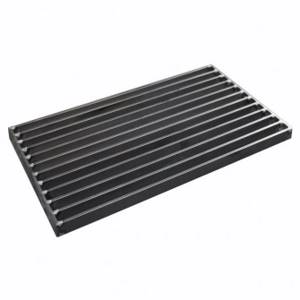
In private homes, stoves, boilers and fireplaces are often installed, which, despite their differences, have one common detail - the grate. It may differ in its shape, size and material, but its purpose remains the same in all designs.
The performance of stoves, fireplaces and boilers, as well as their efficiency, largely depends on whether the element is manufactured correctly, how accurately it is placed in the combustion chamber, and also on the material from which it is made.
Related Posts
- Ventilation grilles for window sills
- Grate for boilers and furnaces
- Homemade Russian stove on the street under a canopy
- Wood-burning stoves and their variety of designs
- How to choose a stove for an Ermak sauna: top 7 models with descriptions of technical characteristics and customer reviews
- Types of Kuznetsov furnaces and their order
- How to weld a metal sauna stove
- Buleryan oven: do it yourself
- How to fold a Swedish oven with a stove
- How to make a long-burning stove yourself
- Types and sizes of Russian stoves: types, sizes, 5 construction recommendations
- Lesson 31. how to install a ventilation grill in the bathroom
- Fast and correct furnace repair
- 9 types of heat-resistant tiles for fireplaces and stoves: choosing the best
- Manufacturing and connecting a sauna stove with a water heat exchanger
- A stove with a water circuit for heating a house: features of stove heating + choosing the optimal option
- How to install a ventilation grille for a ventilation duct in the kitchen
- Cast iron stove for bath Vesuvius
- Do-it-yourself stove-fireplace
- Secrets of stove makers: brick stove for a bath
- Induction furnace lining
- DIY metal rocket oven
- Fire-battery 7b (thermophor)
- Types of stoves for the home: classification and review of equipment from the best manufacturers
- Installing a stove in a steam room: location, fencing, protective screen
Read with this
- Ventilation grilles for window sills
- Grate for boilers and furnaces
- Homemade Russian stove on the street under a canopy
- Wood-burning stoves and their variety of designs
- How to choose a stove for an Ermak sauna: top 7 models with descriptions of technical characteristics and customer reviews
- Types of Kuznetsov furnaces and their order
- How to weld a metal sauna stove
- Buleryan oven: do it yourself
- How to fold a Swedish oven with a stove
- How to make a long-burning stove yourself
